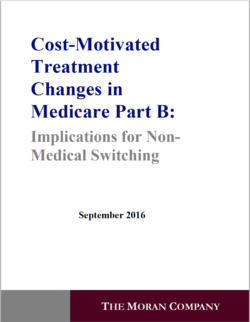Cost-Motivated Treatment Changes in Medicare Part B: Implications for Non-Medical Switching
September 23, 2016
 Under prevailing benefit designs in both public and private health insurance systems, patients may find that pivotal decisions about their health care hinge on financial, not medical, factors. In some cases, cost-sharing burdens or changes in patients’ financial situations may lead patients and their health care providers to select or switch treatment options because they are affordable for the patient, not necessarily because they present the best treatment options. In other situations, patients may face the prospect of “non medical switching” from one prescription drug or biological to another therapy. Whether by conscious design or inadvertent result, patients with significant chronic disease whose condition has been stabilized on a particular drug regimen can lose access to continued coverage for their therapy, forcing physicians to switch the patient’s prescription to an alternative drug.
Under prevailing benefit designs in both public and private health insurance systems, patients may find that pivotal decisions about their health care hinge on financial, not medical, factors. In some cases, cost-sharing burdens or changes in patients’ financial situations may lead patients and their health care providers to select or switch treatment options because they are affordable for the patient, not necessarily because they present the best treatment options. In other situations, patients may face the prospect of “non medical switching” from one prescription drug or biological to another therapy. Whether by conscious design or inadvertent result, patients with significant chronic disease whose condition has been stabilized on a particular drug regimen can lose access to continued coverage for their therapy, forcing physicians to switch the patient’s prescription to an alternative drug.
Sometimes, non-medical switching occurs due to changes in the degree of cost sharing obligations the patient faces. In other cases involving private payers, it is the conscious result of explicit care management interventions, such as formulary changes, insurer incentives or limitation or rejection of copay coupons. Whatever the mechanism by which non medical switching is induced, it raises significant clinical issues for patients who find themselves being switched from a therapy known to be working toward a therapy of presently unknown efficacy.
The immediate consequence of cost-motivated treatment changes is the potential for treatment failure. In the intermediate and longer term, the consequences of remediating that treatment failure may be substantial, potentially off-setting some or all of the immediate “savings” that accrue because of the switch in therapies.
To begin exploring the impact of cost-motivated changes in treatment, the Institute for Patient Access retained The Moran Company to investigate whether the effect of such changes on Medicare spending could be demonstrated by analyses of Medicare claims data. In the present study, our analysis is limited to Medicare Part B, since data on this program are readily available and present a picture of patients with generally stable health coverage. In follow-on work, we expect to use commercial claims data to look at non-medical switching issues more broadly.
For the current study, we conducted a set of descriptive analyses performed employing historical Medicare claims data to understand the prevalence of therapeutic switching in Medicare, as well as the patterns of service and resource use downstream of switching events. Our focus in this study was a longitudinal analysis of patient use of drugs and biologicals covered by Medicare Part B, as well as Medicare spending of selected patients before and after a switching event. Our analyses focused on patients with rheumatoid arthritis, Crohn’s disease, and a diagnosis of immunodeficiency.
Tags: Non-Medical SwitchingCategorized in: Analysis

